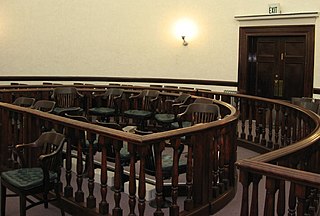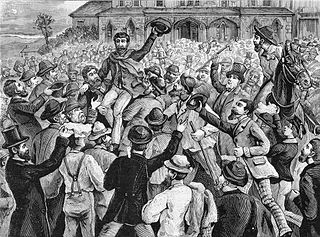Double jeopardy is a procedural defence that prevents an accused person from being tried again on the same charges following an acquittal in the same jurisdiction. A variation in civil law countries is the peremptory plea, which may take the specific forms of autrefois acquit or autrefois convict. These doctrines appear to have originated in ancient Roman law, in the broader principle non bis in idem.

A jury trial, or trial by jury, is a lawful proceeding in which a jury makes a decision or findings of fact. It is distinguished from a bench trial in which a judge or panel of judges makes all decisions.

The Sixth Amendment to the United States Constitution sets forth rights related to criminal prosecutions. It was ratified in 1791 as part of the United States Bill of Rights. The Supreme Court has applied most of the protections of this amendment to the states through the Due Process Clause of the Fourteenth Amendment.

A jury is a sworn body of people convened to render an impartial verdict officially submitted to them by a court, or to set a penalty or judgment. Juries developed in England during the Middle Ages, and are a hallmark of the Anglo common law legal system. They are still commonly used today in Great Britain, the United States, Canada, Australia, and other countries whose legal systems are descended from England's legal traditions.
Burden of proof is a legal duty that encompasses two connected but separate ideas that apply for establishing the truth of facts in a trial before tribunals in the United States: the "burden of production" and the "burden of persuasion." In a legal dispute, one party is initially presumed to be correct, while the other side bears the burden of producing evidence persuasive enough to establish the truth of facts needed to satisfy all the required legal elements of legal dispute. There are varying types of burden of persuasion commonly referred to as standards of proof, and depending on the type of case, the standard of proof will be higher or lower. Burdens of persuasion and production may be of different standards for each party, in different phases of litigation. The burden of production is a minimal burden to produce at least enough evidence for the trier of fact to consider a disputed claim. After litigants have met the burden of production, they have the burden of persuasion: that enough evidence has been presented to persuade the trier of fact that their side is correct. There are different standards of persuasiveness ranging from a preponderance of the evidence, where there is just enough evidence to tip the balance, to proof beyond a reasonable doubt, as in United States criminal courts.
Jury nullification (US), jury equity (UK), or a perverse verdict (UK) refers to when members of a criminal trial's jury believe that a defendant is guilty, but choose to acquit the defendant anyway. Reasons may include beliefs that: the law itself is unjust, the prosecutor has misapplied the law in the defendant's case, the punishment for breaking the law is too harsh, or general frustrations with the criminal justice system. Some juries have also refused to convict due to their own prejudices in favor of the defendant.

In common law jurisdictions, an acquittal certifies that the accused is free from the charge of an offense, as far as the criminal law is concerned. The finality of an acquittal is dependent on the jurisdiction. In some countries, such as the United States, an acquittal operates to bar the retrial of the accused for the same offense, even if new evidence surfaces that further implicates the accused. The effect of an acquittal on criminal proceedings is the same whether it results from a jury verdict or results from the operation of some other rule that discharges the accused. In other countries, the prosecuting authority may appeal an acquittal similar to how a defendant may appeal a conviction.
The presumption of innocence is a legal principle that every person accused of any crime is considered innocent until proven guilty. Under the presumption of innocence, the legal burden of proof is thus on the prosecution, which must present compelling evidence to the trier of fact. If the prosecution does not prove the charges true, then the person is acquitted of the charges. The prosecution must in most cases prove that the accused is guilty beyond a reasonable doubt. If reasonable doubt remains, the accused must be acquitted. The opposite system is a presumption of guilt.
Not proven is a verdict available to a court of law in Scotland. Under Scots law, a criminal trial may end in one of three verdicts, one of conviction ("guilty") and two of acquittal.
Three basic features of Japan's system of criminal justice characterize its operations. First, the institutions—police, government prosecutors' offices, courts, and correctional organs—maintain close and cooperative relations with each other, consulting frequently on how best to accomplish the shared goals of limiting and controlling crime. Second, citizens are encouraged to assist in maintaining public order, and they participate extensively in crime prevention campaigns, apprehension of suspects, and offender rehabilitation programs. Finally, officials who administer criminal justice are allowed considerable discretion in dealing with offenders.
In criminal law, a conspiracy is an agreement between two or more persons to commit a crime at some time in the future. Criminal law in some countries or for some conspiracies may require that at least one overt act be undertaken in furtherance of that agreement, to constitute an offense. There is no limit on the number participating in the conspiracy and, in most countries, no requirement that any steps have been taken to put the plan into effect. For the purposes of concurrence, the actus reus is a continuing one and parties may join the plot later and incur joint liability and conspiracy can be charged where the co-conspirators have been acquitted or cannot be traced. Finally, repentance by one or more parties does not affect liability but may reduce their sentence.

The Criminal Justice Act 2003 is an Act of the Parliament of the United Kingdom. It is a wide-ranging measure introduced to modernise many areas of the criminal justice system in England and Wales and, to a lesser extent, in Scotland and Northern Ireland.
In the law of criminal evidence, a confession is a statement by a suspect in crime which is adverse to that person. Some secondary authorities, such as Black's Law Dictionary, define a confession in more narrow terms, e.g. as "a statement admitting or acknowledging all facts necessary for conviction of a crime," which would be distinct from a mere admission of certain facts that, if true, would still not, by themselves, satisfy all the elements of the offense. The equivalent in civil cases is a statement against interest.
A French cour d'assises, or Assize Court, is a criminal trial court with original and appellate limited jurisdiction to hear cases involving defendants accused of felonies, i.e. crimes as defined in French. It is the only French court consisting in a jury trial.
In criminal law, a mitigating factor, also known as extenuating circumstances, is any information or evidence presented to the court regarding the defendant or the circumstances of the crime that might result in reduced charges or a lesser sentence. Unlike a legal defense, it cannot lead to the acquittal of the defendant. The opposite of a mitigating factor is an aggravating factor.
Jury nullification in the United States has its origins in colonial America under British law. In the United States, jury nullification occurs when a jury in a criminal case reaches a verdict contrary to the weight of evidence, sometimes because of a disagreement with the relevant law. The American jury draws its power of nullification from its right to render a general verdict in criminal trials, the inability of criminal courts to direct a verdict no matter how strong the evidence, the Fifth Amendment's Double Jeopardy Clause, which prohibits the appeal of an acquittal, and the fact that jurors cannot be punished for the verdict they return.
The Double Jeopardy Clause of the Fifth Amendment to the United States Constitution provides: "[N]or shall any person be subject for the same offence to be twice put in jeopardy of life or limb..." The four essential protections included are prohibitions against, for the same offense:
Georgia v. Brailsford, 3 U.S. 1 (1794), was an early United States Supreme Court case holding that debts sequestered but not declared forfeit by states during the American Revolution could be recovered by bondholders. It is significant as the only reported jury trial in the history of the Supreme Court.
A citizen’s right to a trial by jury is a central feature of the United States Constitution. It is considered a fundamental principle of the American legal system.
Cruz v. New York, 481 U.S. 186 (1987), was an important United States Supreme Court decision which held that the Confrontation Clause barred the admission, in a joint trial, of a nontestifying codefendant's confession incriminating the defendant, even if the defendant's own confession was admitted against him.





